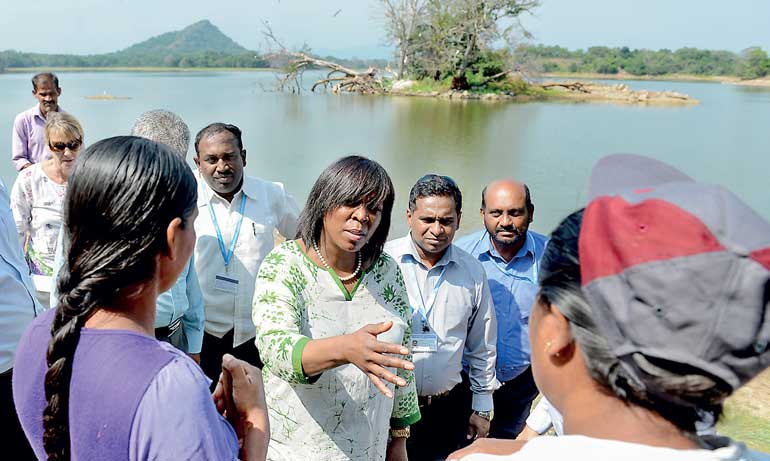Monday Apr 07, 2025
Monday Apr 07, 2025
Tuesday, 14 February 2017 00:00 - - {{hitsCtrl.values.hits}}
 United Nations World Food Program (WFP) Executive Director Ertharin Cousin meets people as she visits the village of Tanamalwila in Monaragala district, about 210 kilometers (131 miles) southeast of Colombo. Cousin visited Sri Lanka for the launch of the “National Strategic Review of Food Security and Nutrition Towards Zero Hunger” program and to see the effects of the ongoing drought in Sri Lanka - AFP
United Nations World Food Program (WFP) Executive Director Ertharin Cousin meets people as she visits the village of Tanamalwila in Monaragala district, about 210 kilometers (131 miles) southeast of Colombo. Cousin visited Sri Lanka for the launch of the “National Strategic Review of Food Security and Nutrition Towards Zero Hunger” program and to see the effects of the ongoing drought in Sri Lanka - AFP
By Chamodi Gunawardane
The Disaster Management Ministry yesterday warned of the drought conditions spreading across more areas in the country in the coming months, with it creating possible drinking water shortages, bushfires and further crop damage.
The prevailing dry weather conditions have already affected the Maha season of paddy cultivation with part of the cultivated crop being damaged, reducing the predicted yield for the year to 1.3 MT from 1.7 MT.
“Out of a total of 800,000 hectares usually cultivated for the Maha season, this year only 491,000 hectares were cultivated and of this another 100,000 hectares suffered crop damage, reducing the predicted yield further,” Agriculture Department Director General Dr. Rohan Wijekoon told Daily FT.
Accordingly, 344,894 MT of paddy during the 2016/2017 Maha cultivation season has been damaged due to the dry weather conditions.
As the water level of the main rivers and tanks in the country continues to drop, the Government has appealed to the public to conserve water, while also calling for them to refrain from polluting the country’s main water sources.
Although there is no severe shortage at present, the authorities are continuing to monitor the situation, National Water Supply and Drainage Board Director General G. A. Kumararatne said.
“Currently, the country is not facing a severe shortage of water. The water board has however taken precautionary measures and launched a tube well program in some of the drought-hit areas. In some areas like Kalutara the salinity of the water has increased but other than that we hope to be able to manage,” he said, adding that pollution of water sources had complicated the purification process.
“When there is pollution of water sources as the water levels reduce then the concentration of pollution increases. It becomes difficult and costly to purify the water,” Kumararatne said.
According to a statement released by the Government Information Department, 14 districts including Anuradhapura, Kilinochchi, Gampaha, Hambantota, Jaffna, Kurunegala, Moneragala, Mullaitivu, Puttalam, Ratnapura, Trincomalee, Kandy, Vavuniya and Kegalle, have been severely affected by the current conditions.
Affected communities are faced with drinking water shortages, a statement issued by the Information Department said. It further said that around 493,386 people from 129,601 families belonging to 87 Divisional Secretaries have been affected by the dry weather and they are suffering from a drinking water shortage.
The Disaster Management Centre has made the necessary facilities available to supply drinking water to those affected. Accordingly, the centre has already deployed 4,798 water tanks and 349 water bowsers to provide drinking water. However, a total of 7,922 water tanks and 594 water bowsers are needed to cater to the current requirement. Moves are also under way to procure more bowsers and tanks, the statement said.
Discover Kapruka, the leading online shopping platform in Sri Lanka, where you can conveniently send Gifts and Flowers to your loved ones for any event including Valentine ’s Day. Explore a wide range of popular Shopping Categories on Kapruka, including Toys, Groceries, Electronics, Birthday Cakes, Fruits, Chocolates, Flower Bouquets, Clothing, Watches, Lingerie, Gift Sets and Jewellery. Also if you’re interested in selling with Kapruka, Partner Central by Kapruka is the best solution to start with. Moreover, through Kapruka Global Shop, you can also enjoy the convenience of purchasing products from renowned platforms like Amazon and eBay and have them delivered to Sri Lanka.
Discover Kapruka, the leading online shopping platform in Sri Lanka, where you can conveniently send Gifts and Flowers to your loved ones for any event including Valentine ’s Day. Explore a wide range of popular Shopping Categories on Kapruka, including Toys, Groceries, Electronics, Birthday Cakes, Fruits, Chocolates, Flower Bouquets, Clothing, Watches, Lingerie, Gift Sets and Jewellery. Also if you’re interested in selling with Kapruka, Partner Central by Kapruka is the best solution to start with. Moreover, through Kapruka Global Shop, you can also enjoy the convenience of purchasing products from renowned platforms like Amazon and eBay and have them delivered to Sri Lanka.